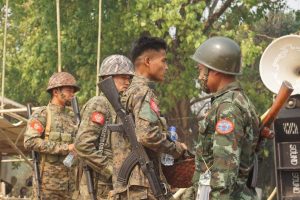Myanmar’s Rakhine State, which borders Bangladesh to the west, is now relatively stable despite the country’s escalating countrywide civil war, under de facto control of the Arakan Army (AA), one of the country’s most powerful ethnic armed groups. Established in 2009 with its political goal of greater autonomy for the people of Rakhine, the AA claims that it now has 30,000 people under arms, around 6,000 of which are supporting its ethnic allies and resistance groups in Kachin, Karen, and Shan states and elsewhere in the country.
Since it began clashing with the Myanmar military in western Myanmar in 2015, the AA created a plan to gain the support of the Rakhine people through a promise that it termed “the 2020 Arakan Dream.” As part of its dream, the AA by the end of 2020 formed a strong military base and its own administration in Rakhine. Six months after the 2021 coup, the AA claimed it had de facto control over two-thirds of the state.
Despite the resumption of fighting in August 2022, the AA agreed to a “temporary truce” with the Myanmar military in late November, which intended to allow the INGOs, NGOs, and local civil society groups to deliver humanitarian aid to those displaced by the conflict. The AA had previously fought intensely with the military from 2018 to 2020, and ended with an informal crossfire just days before the national election in November 2020.
The current truce notwithstanding, the military has been preparing for another round of war, reinforcing its troops in western Myanmar and setting aside stores of food for the long term. For its own part, the AA has chosen to chase its political goal, which is essentially a high degree of autonomy for Rakhine State. Many analysts have argued that the AA will not achieve its political goal as long as the junta regime is in power. It is obvious that the regime will not ever grant greater autonomy in Rakhine, where mega projects are being implemented by China and India.
Furthermore, the opposition National Unity Government, should it come to power, would likely follow its federal charter, which envisions a lesser degree of regional power-sharing than what the AA demands. Additionally, the NUG may be worried that giving much military and political power to the AA would lead other powerful ethnic armed groups such as Karen National Union and Kachin Independence Organization to make similar demands, or could lead to the Balkanization of the country. Shortly after the coup, the relations between the NUG and AA cooled, but a year later their relationship seems to be improving and they are also believed to have informally reached some agreement, including a commitment to fight until the revolution wins and to support each other.
Six months after the coup, in August 2021, Maj.-Gen. Twan Mrat Naing, the leader of the AA, claimed nevertheless that in the pursuit of the long-standing Arakan dream, there will be no compromise. In early 2019, he also once told the Irrawaddy News, that a “confederation” was the only option for the people of Rakhine state.
In preparation for the realization of its political objectives, soon after the 2021 coup, the AA tried strategically to use the coup as an opportunity to fight the junta forces as a common enemy, along with some other ethnic minority armies and the new armed resistance groups. The AA seems to have realized that it would never achieve its goal for the people of Rakhine State under the military junta.
On the occasion of the 14th anniversary of the AA’s establishment on April 10, 2023, at least 40 congratulatory statements were sent by other anti-coup resistance groups, including the NUG. The statements generally emphasized a common commitment to fighting the junta until the military loses control of the country, and most resistance groups’ statements are also believed to have expressed support for the AA’s political goal.
Through these statements, the AA disclosed a couple of clear strategies: first, to weaken and threaten its enemy, the junta, by any military or nonviolent means; and second, to seek support for its goal of greater political and strategic autonomy for Rakhine State. To win support from other forces battling the junta, the AA has provided training or arms for at least 15 other resistance groups, most of them located in Chin State and Magwe, Bago, and Ayeyarwaddy regions, bordering Rakhine, who are now also engaging in war with the junta forces. This geographic strategy, which is being pursued, while the AA has accelerated the creation of its own administration and judicial mechanisms in Rakhine, would seem to pose a serious threat to the military leadership.
Yet, the most critical time still lies ahead. The realization of the dream of confederation will depend not only on the degree of military build-up by the AA but also on the state of the resistance forces that enjoy the AA’s support, which also still require military equipment and greater organizational capacity if they successfully challenge the junta and its forces. For the NUG, there is the question of how much control it has over these resistance forces. Their close association with the AA could mean that these anti-coup local forces are likely to adopt a unique vision of a federal structure for Myanmar, one more inclined toward the confederation model imaged by the AA than to the less devolved vision of the NUG.
But all that is in the future. For now, the AA and the NUG have to fight a common enemy and put these future challenges on the back burner until the military junta is defeated.

































